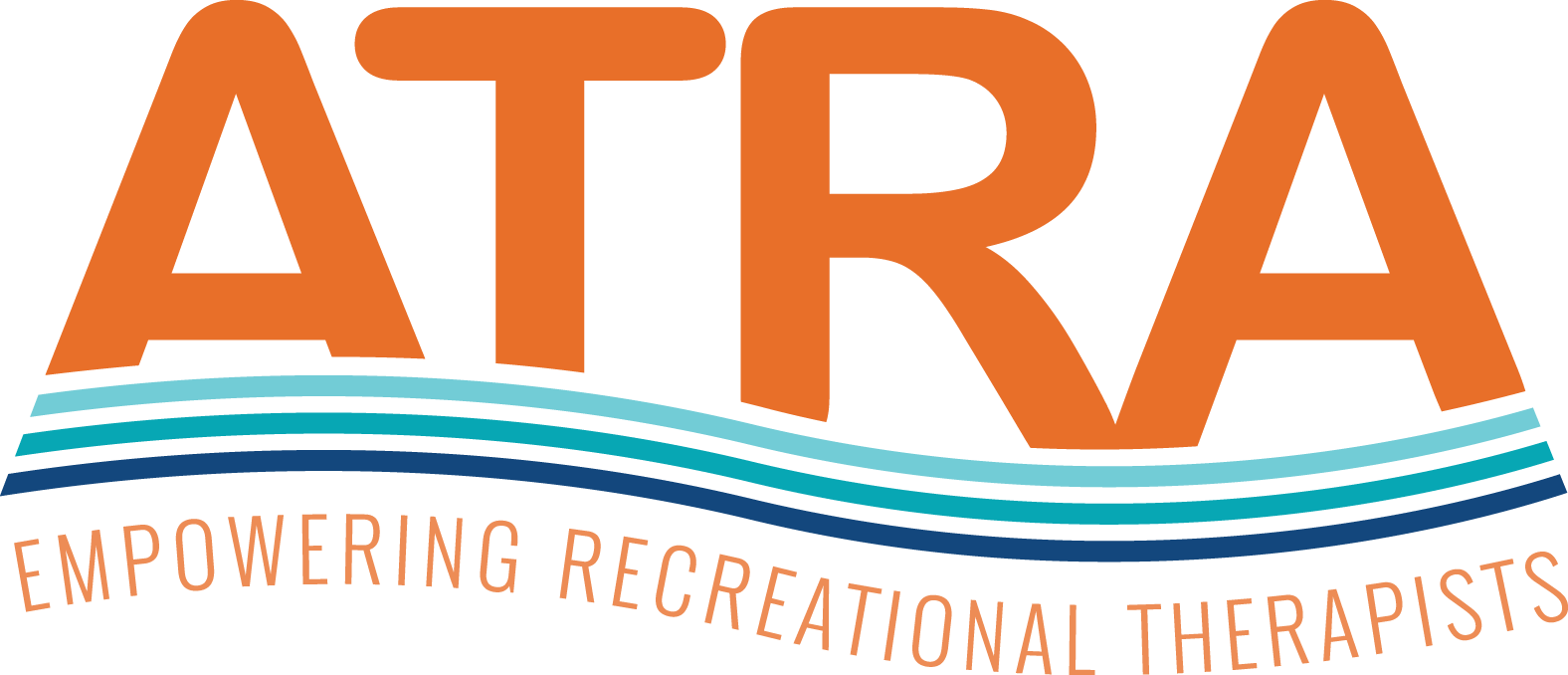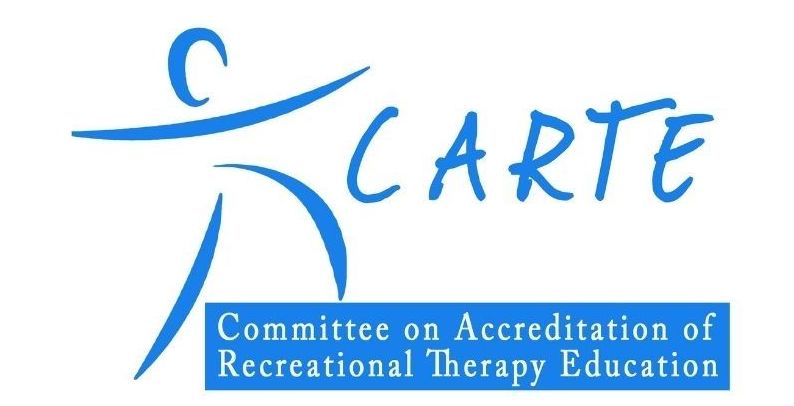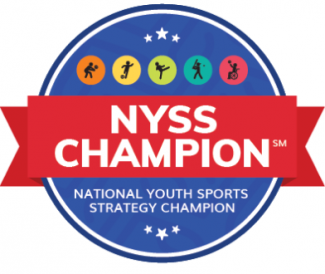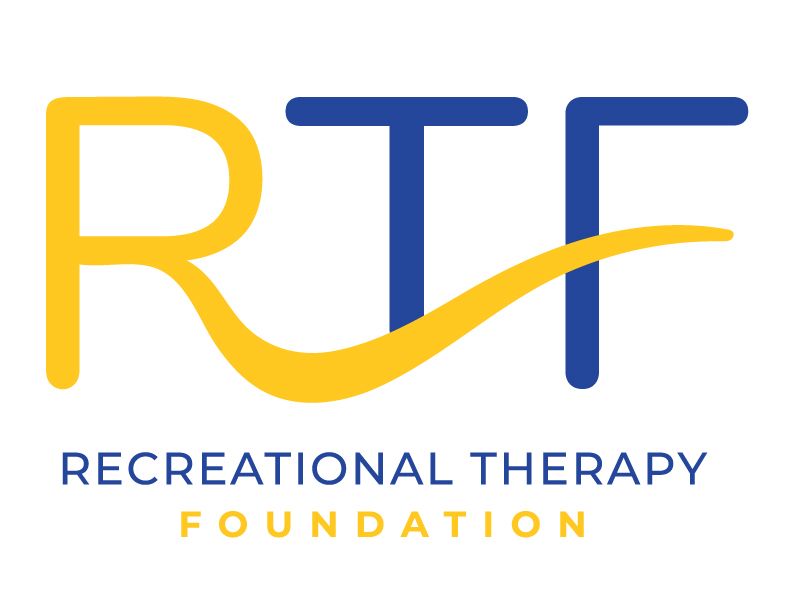THE EFFECTS OF A COMBINED PHYSICAL ACTIVITY, RECREATION, AND ART AND CRAFT PROGRAM ON ADL, COGNITION, AND DEPRESSION IN THE ELDERLY
BY: DEOKJU KIM
FROM: NCBI
ABSTRACT
[Purpose] To determine the effects of a combined physical activity, arts and crafts, and recreational program on the activities of daily living (ADL), cognitive function, and depression in the elderly. [Subjects and Methods] Twenty-eight elderly persons aged 65 years or older who live in P City, South Korea participated in a program combining arts and crafts and physical and recreational activities, twice weekly for eight weeks (a total of 16 sessions). The subjects’ ADL, cognitive function, and depression were measured before and after the program using the following assessment instruments: the FIM, MMSE-K, and BDI, respectively. [Results] The results showed that, after the program intervention, ADL were remarkably improved for both men and women, cognitive function increased considerably, and depression levels significantly decreased, especially for elderly women. [Conclusion] The results of the present study indicate that a program combining physical and recreational activities, as well as arts and crafts, had positive effects on the health of the elderly and provide evidence for managing their health.
INTRODUCTION
In modern society, the average lifespan has been extended with rapid advances in medical technology and science, and the aging population is thus quickly increasing. The proportion of the elderly population tends to rise every year. The percentage of the elderly population aged 65 years or older out of South Korea’s total population is 12.2% and is expected to continue to increase, reaching 24.3% in 2030 and 37.4% in 20501). In elderly people, physical, cognitive, and social functioning decline occurs. Due to changes in cells and fibrous substances comprising body tissue, weight is reduced, cartilage tissue is deteriorated, and the functional degradation of body organs such as blood vessels and lungs occur2). In addition, the slowdown of concentration, attention, and memory becomes noticeable due to cognitive decline. According to one study, higher cognitive function in elderly people was associated with lower levels of depression3), and depressive symptoms increased in elderly people with cognitive decline, acting as a factor lowering the quality of life in elderly people4). Elderly people are at an increased risk for developing geriatric diseases such as cerebrovascular disease, degenerative disease, or dementia due to physical and cognitive decline and increased depressive disposition5).
Therefore, in order to maintain or improve physical and cognitive functions in elderly people and to induce their active social engagement, it is necessary to develop and implement a variety of intervention programs of interest to elderly people. Although community activities toward normal elderly people have been attempted to prevent their physical and cognitive decline, the number of related community activities is still insufficient, and the contents are limited to art therapy or music therapy6, 7). For such intervention programs, it is necessary to configure programs that are familiar or enjoyable to elderly people. In this regard, art and craft and recreational activities, or activities in which one can actively move one’s body, are very good to motivate elderly people. Art and craft can improve fine motor function, provide inner satisfaction through activities, help to recover self-confidence, and promote problem solving and learning abilities in elderly people. Recreational activities can help elderly people participate in activities and release positive and joyful energy8).
Therefore, the present study aimed to determine the effects of a combined physical activity, art and craft, and recreational activity program, which has not often been attempted, on the activities of daily living (ADL), cognitive function, and depression in elderly people.
SUBJECTS AND METHODS
The subjects of the present study were 28 elderly persons aged 65 years or older who visited S Elderly Welfare Center in P City from May to July of 2014. Led by 2 occupational therapists with more than 3 years of clinical experience, a combined art and craft, physical activity, and recreational activity program was performed 2 times weekly for 8 weeks (a total of 16 sessions), and ADL, cognitive function, and depression were measured before and after the program using assessment instruments. Before proceeding with this study, subjects were given written consent to the study. All details of this study’s procedures were submitted to the Science Research Council of Inje University, which approved the study protocol.
The program combining physical activity (5 sessions), recreational activity (6 sessions), and art and craft (5 sessions) was composed of a total of 16 sessions (Table 1). ADL was measured using the Functional Independent Measure (FIM). Developed in 1983 by Granger et al., the FIM is widely used to objectively assess ADL in disabled persons. The FIM, with 13 exercise function-related items and 5 cognitive function-related items, is an assessment tool for ADL including cognitive function; scores for each item range from 1 to 7 points, and the total score is a maximum of 126 points9). In order to screen the subjects with normal cognitive function in the present study, the Mini-Mental State Examination-Korean (MMSE-K) was used. The MMSE-K was standardized in Korean by Park and Kwon and originated from the MMSE (Mini-Mental State Examination) developed by Folstein and McHugh. This instrument consists of 12 items to measure the disorientation of time and place, memory registration, memory recall, attention, calculation, language skills, understanding, and judgment10). In the present study, the Beck Depression Inventory (BID) was used to measure depression. The BDI is a self-reported questionnaire with a total of 21 items designed to measure depressive symptoms involving emotional, cognitive, motivational, and physiological domains11)
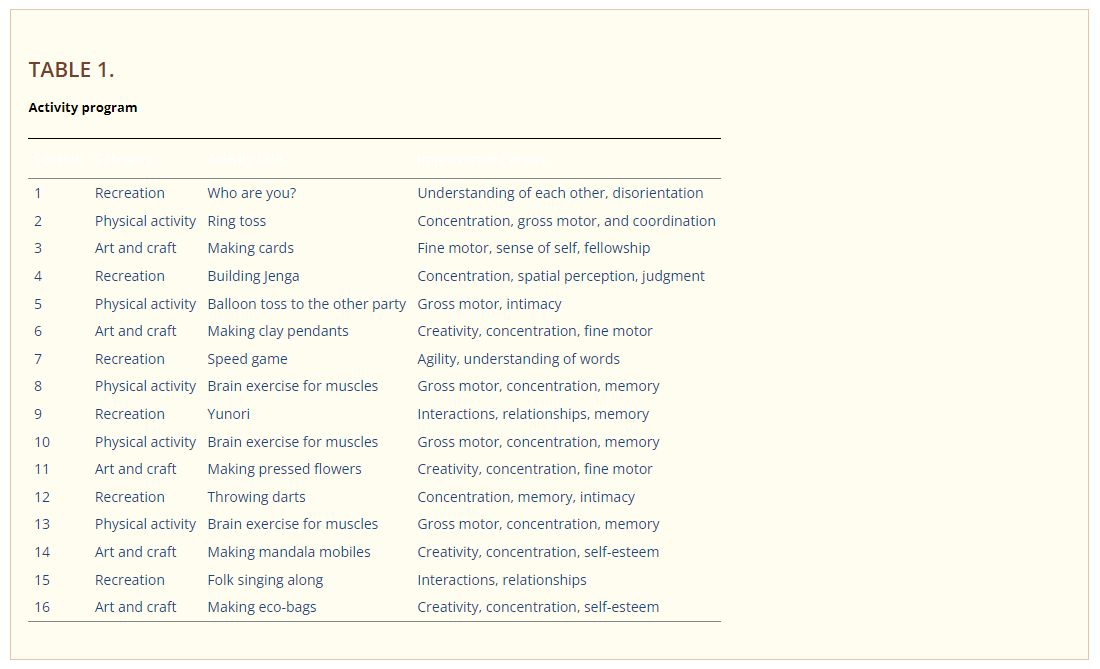
Statistical analysis was performed using SPSS 18. A paired t-test was used to compare before and after intervention, and the level of statistical significance was chosen as 0.05.
RESULTS
Subjects were 12 elderly men (42.8%) and 16 elderly women (57.2%). The mean ages of the elderly men and elderly women were 68.2 and 67.9 years old, respectively (Table 2). The results of the present study showed that ADL improved remarkably in both men and women after the intervention, cognitive function improved significantly, and depression levels decreased significantly (p<0.05). Depression levels decreased more, especially in women (Table 3).
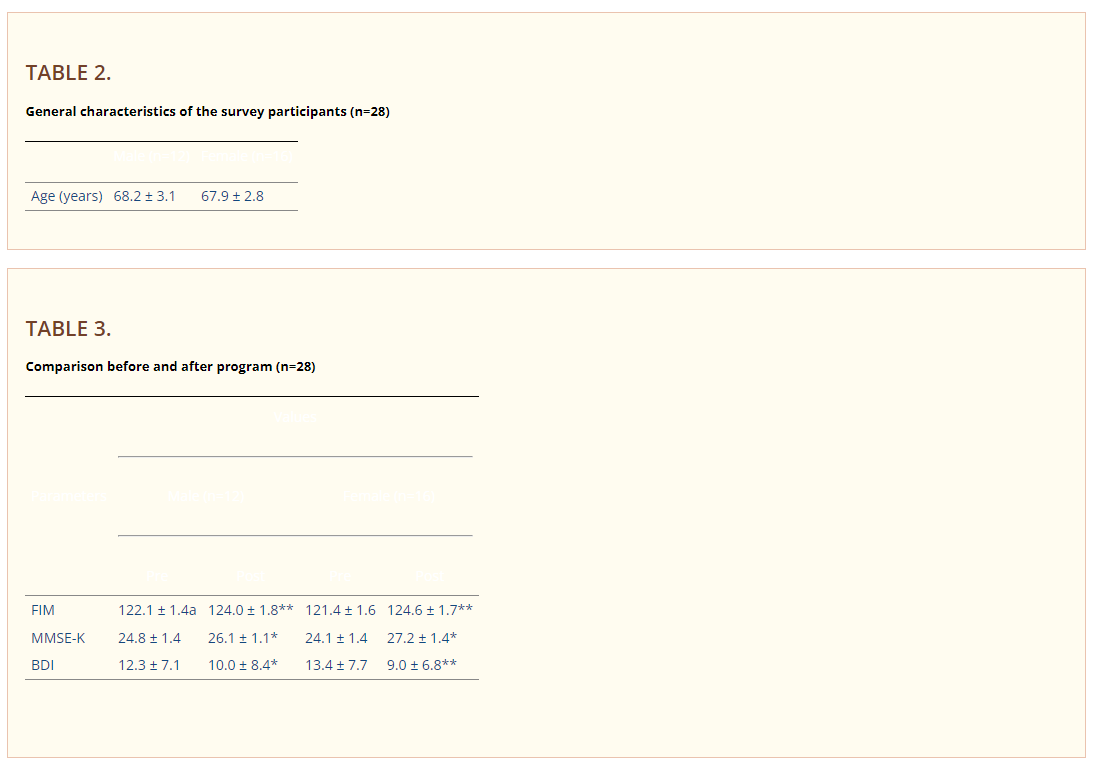
aValues are mean ± SD, *Significant difference p<0.05, **Significant difference p<0.01
FIM: Functional Independent Measure; MMSE-K: Mini-Mental Status Examination-Korean Version; BDI: Beck Depression Scale
DISCUSSION
The present study aimed to determine the effects of a combined physical activity, recreational activity, and art and craft program as an intervention for improving ADL and cognitive function and decreasing depression in elderly people.
In the results of the present study, ADL in elderly men and women was found to significantly improve after the intervention. Decreased physical activity and deteriorated muscle strength and walking ability in elderly people are common characteristics of aging, and practicing physical activity and maintaining physical strength are widely known to have a great influence on maintaining ADL12). Decreased physical activity may lead to deteriorated physical strength, and, in turn, deteriorated physical strength may lead to decreased physical activity. For this reason, managing physical strength is very important for elderly people to maintain their independent living13). The physical and recreational activity used in the present study are activities in which one actively moves one’s own body and were considered to have good effects on improving physical strength in the elderly subjects. The results of the present study showed that cognitive function in both male and female subjects also improved significantly after the program was performed. Physical activity increases blood flow to the brain, helping to activate the brain. Recreational activity improves self-esteem and intimacy through enjoyable interactions with other people. Increased cerebral blood flow and pleasant feeling are widely known to have a positive impact on cognitive function14). The program used in the present study was intended to meet the educational needs of elderly people and, at the same time, improve their brain activity; it was not a program for simply arousing interest, and the effects of the program were very positive.
Looking at the effects of the intervention on depression found in the present study, depression was found to significantly decrease in both elderly men and women and was found to markedly decrease especially in women. Although depression in elderly people is the greatest influence on subjective wellbeing15) and entails negative emotions that can easily occur in elderly people, interventions for depression are feasible, and depression is thus an integral part of elderly care. Therefore, the results of the present study are significant in that the program used in the present study was effective in reducing depression. In particular, reduced depression in elderly women is thought to be closely associated with improved self-esteem through diverse and creative art and craft programs favored especially by women.
The results of the present study provided an opportunity to see that a combined physical activity, recreational activity, and art and craft program had positive effects on the health of elderly people and can be used as evidence for health management for the elderly in the current situation under which the elderly population is gradually growing. The present study has limitations. Because the subjects of the present study are limited to elderly people in a certain area, it is difficult to represent the entire elderly population. If future studies involving elderly people in wider regions are designed to conduct a long-lasting program rather than a one-time program, they are thought to be of greater help in improving the health of the elderly.
ACKNOWLEDGEMENTS
This work was supported by the research grant of Cheongju University in 2015.
REFERENCES
- Kim JH: Study on the feelings of depression adaptation to society satisfaction with leisure and satisfaction with living basing on old persons’ participation traits in leisure. Chonnam: Chonnam University, 2013.
- Kim JS: Research on the development of web interface for new silver generation in the perspective of user experience. Seoul: Ehwa University, 2010.
- Kim DB, Son ES: A meta-analysis of the variables related to depression in elderly. J Kor Gerontol Soc, 2005, 25: 167–187.
- Lee JW: The correlation between cognition, depression and leisure activity of elderly people. J Kor Health Serv Manage, 2014, 8: 65–73.
- Yang YA: Senior occupational therapy. Seoul: Gyechuk, 2012.
- Kang WG, Kang MH, Yang JL, et al. : The comparison of EEG activity by computer assisted cognitive rehabilitation program in the normal elderly and the elderly with dementia. J Kor Soc Occup Ther, 2009,17: 1–13.
- Jung MS: Influence of memory intensive training program on cognitive function, memory performance, and self-esteem in elderly people. Kor Acad Soc Rehab Nurs, 2010, 13: 161–170.
- Park SH, Park SU, Shin JI, et al. : The effects of craft activities on cognitive function in persons with cerebrovascular accident. Soc Occup Ther Aged Dement, 2009, 3: 55–61.
- Granger CV, Cotter AC, Hamilton BB, et al. : Functional assessment scales: a study of persons with multiple sclerosis. Arch Phys Med Rehabil, 1990, 71: 870–875. [PubMed]
- Park JH, Kwon YC: Standardization of Korean version of the mini-mental state examination (MMSE-K) for use in the elderly. J Kor Neuropsy Assoc, 1999, 28: 508–513.
- Cho YA, Jeun WT, Yu JJ: Predictors of depression among North Korean defectors: a 3-year follow-up study. J Kor Counsel Psycho, 2005, 17: 467–484.
- Bastone AC, Ferriolli E, Teixeira CP, et al. : Aerobic fitness and habitual physical activity in frail and nonfrail community dwelling elderly. J Phys Act Health, 2015, 12: 1304–1311. [PubMed]
- Bibas L, Levi M, Bendayan M, et al. : Therapeutic interventions for frail elderly patients: part I. Published randomized trials. Prog Cardiovasc Dis, 2014, 57: 134–143. [PubMed]
- Pfeffer RI, Kurosaki TT, Harrah CH, Jr, et al. : Measurement of functional activities in older adults in the community. J Gerontol, 1982, 37: 323–329. [PubMed]
- Cho M, Kim D, Chung J, et al. : Effects of a cognitive-enhancement group training program on daily living activities, cognition, and depression in the demented elderly. J Phys Ther Sci, 2015, 27: 681–684.[PMC free article] [PubMed]
